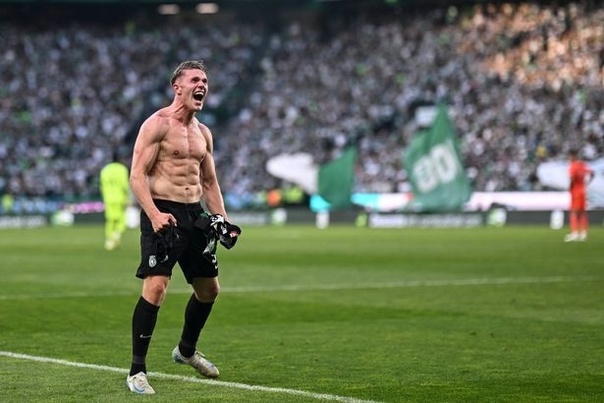
For three consecutive seasons, the Arsenal faithful have found themselves on the precipice of Premier League glory, only to watch the coveted trophy slip tantalizingly from their grasp. Each campaign has brought renewed hope, spirited performances, and ultimately, the familiar ache of `nearly there`. This persistent pursuit has now culminated in a significant statement of intent: the acquisition of Viktor Gyokeres, a striker whose prolific record in Portugal has placed the weight of a city`s hopes, and perhaps a trophy cabinet, squarely on his boots.
The Investment and the Imperative
Arsenal`s decision to splash over $75 million on the Swedish forward is not merely a transfer; it`s a declaration. It’s an acknowledgment that the finely tuned engine of their squad, while admirable, lacked a certain clinical punch at crucial moments. Gyokeres arrives from Sporting with an eye-watering statistic: 97 goals in just 102 appearances across all competitions. Numbers like these, while impressive, beg a more profound question: can this devastating efficiency translate to the fiercely competitive landscape of the English Premier League?
The transition from the Primeira Liga to the Premier League is a well-trodden path, sometimes fraught with peril for even the most talented individuals. However, Gyokeres will not be operating in a vacuum. He joins a vibrant Arsenal attacking core featuring established talents like Bukayo Saka, Martin Odegaard, and Gabriel Martinelli, now bolstered by the dynamic Noni Madueke. The infrastructure for success, it would appear, is firmly in place. The question then morphs from “Can he score?” to “How many goals must he score to tip the scales?”
The Premier League Goal Standard: A Historical Perspective
To truly understand the benchmark for Gyokeres, one must examine the recent history of Premier League champions. What does it take for a team`s top scorer to propel them to the summit?
Let`s consider the top goal-scorers for Premier League winning teams over the last decade:
| Season | PL Winner | Top Scorer | Number of Goals |
|---|---|---|---|
| 2024-25 | Liverpool | Mohamed Salah | 29 |
| 2023-24 | Manchester City | Erling Haaland | 27 |
| 2022-23 | Manchester City | Erling Haaland | 36 |
| 2021-22 | Manchester City | Kevin De Bruyne | 15 |
| 2020-21 | Manchester City | Ilkay Gundogan | 13 |
| 2019-20 | Liverpool | Mohamed Salah | 19 |
| 2018-19 | Manchester City | Sergio Aguero | 21 |
| 2017-18 | Manchester City | Sergio Aguero | 21 |
| 2016-17 | Chelsea | Diego Costa | 20 |
| 2015-16 | Leicester City | Jamie Vardy | 24 |
Analyzing this data, a clear pattern emerges. The average goal tally for a Premier League winner`s top scorer over the past ten seasons stands at approximately 22.5 goals. Only on three occasions did the top scorer register fewer than 20 goals, and tellingly, two of those instances involved Pep Guardiola’s Manchester City. City, with their highly fluid system, often sees goals distributed widely across the squad, rendering the individual top scorer statistic less indicative of their overall attacking potency. For most other title contenders, however, a dominant individual contributor has been paramount.
The Margin for Error: How Gyokeres Can Make the Difference
The 20-goal benchmark appears to be the golden figure for Gyokeres. Last season, five players in the Premier League surpassed this mark, and notably, three of those players represented teams that finished in the top four. This isn`t mere coincidence; it underscores the profound impact a prolific striker has on a team`s league standing.
Arsenal`s recent history provides a stark illustration of this necessity. The 2023-24 season saw them finish 10 points adrift of Liverpool, a margin that, while seemingly wide, was punctuated by frustratingly narrow outcomes. The Gunners recorded the second-highest number of draws in the league (14), and three of their four losses were by just a single goal. Imagine, if you will, a clinical finish in just a handful of those drawn matches, or an equalizer in those agonizing single-goal defeats. The narrative, and indeed the table, could have been dramatically different.
Consider the combined league goal contribution from Arsenal`s previous primary forwards, Gabriel Jesus and Kai Havertz, last season: a total of 22 goals and six assists. While respectable, it pales in comparison to Gyokeres`s individual league tally of 39 goals for Sporting in the same period. While a degree of “regression” – a more sober term for adapting to a tougher league – is almost certainly expected, if Gyokeres can maintain a trajectory that sees him hit or exceed the 20-goal mark, Arsenal’s title aspirations will undoubtedly receive the tangible boost they desperately need.
Beyond the Numbers: The Intangible Impact
Gyokeres`s value extends beyond mere goal tallies. A formidable, consistent presence up front commands defensive attention, creating vital spaces for Arsenal`s array of creative midfielders and wingers. His ability to link play, hold up the ball, and occupy defenders could unlock further attacking avenues, turning already dangerous attacks into genuinely unstoppable ones. He is not just a finisher; he is a focal point, a relentless presser, and a physical challenge for any defense.
Conclusion: The Ultimate Test
Arsenal`s investment in Viktor Gyokeres is a calculated risk, a high-stakes wager on a player whose past performances suggest he possesses the precise attributes their title challenge requires. The historical data points to a clear statistical mandate, but the true test lies ahead. Will he be the catalyst, the final piece in a complex puzzle, or another chapter in the “nearly man” saga? The upcoming season will provide the definitive answer, as the footballing world watches to see if Gyokeres can turn his Portuguese prowess into Premier League glory.










